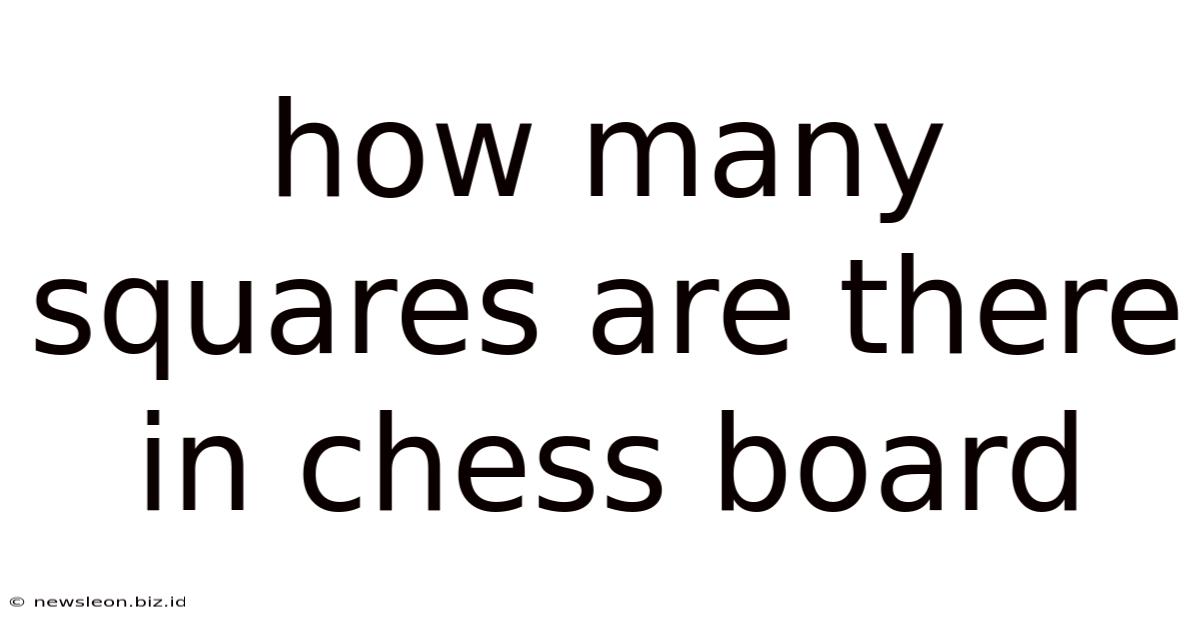How Many Squares Are There In Chess Board
News Leon
May 06, 2025 · 5 min read

Table of Contents
How Many Squares Are There on a Chessboard? A Deep Dive into Combinatorial Math
The seemingly simple question, "How many squares are there on a chessboard?" hides a surprisingly rich mathematical puzzle. While the immediate answer might seem obvious – 64, for the individual squares – the true answer involves a deeper understanding of combinatorial mathematics and geometric series. This article will not only reveal the solution but also explore the underlying principles and offer variations on the problem to further enhance your mathematical intuition.
The Obvious and the Not-So-Obvious
A standard chessboard consists of an 8x8 grid, resulting in 64 individual 1x1 squares. This is the most straightforward observation. However, the problem becomes significantly more complex when we consider squares of larger sizes. We can find squares of size 2x2, 3x3, and so on, all the way up to an 8x8 square encompassing the entire board. This is where the beauty of the problem lies. It's not just about counting the individual squares; it's about systematically identifying all possible squares of various sizes.
Unraveling the Pattern: A Step-by-Step Approach
Let's systematically analyze how many squares of each size exist on the chessboard:
-
1x1 squares: These are the individual squares, and there are 8 rows and 8 columns, giving us a total of 8 * 8 = 64 squares.
-
2x2 squares: To form a 2x2 square, we need to consider the possible starting positions. We can place a 2x2 square in 7 different positions along the rows and 7 different positions along the columns. This gives us 7 * 7 = 49 squares of size 2x2.
-
3x3 squares: Following the same logic, we can place a 3x3 square in 6 positions along the rows and 6 positions along the columns. This results in 6 * 6 = 36 squares of size 3x3.
-
4x4 squares: Continuing the pattern, there are 5 * 5 = 25 squares of size 4x4.
-
5x5 squares: There are 4 * 4 = 16 squares of size 5x5.
-
6x6 squares: There are 3 * 3 = 9 squares of size 6x6.
-
7x7 squares: There are 2 * 2 = 4 squares of size 7x7.
-
8x8 squares: There is only 1 square of size 8x8, encompassing the entire board.
The Summation: Reaching the Final Answer
To obtain the total number of squares on the chessboard, we need to sum the number of squares of each size:
64 + 49 + 36 + 25 + 16 + 9 + 4 + 1 = 204
Therefore, there are a total of 204 squares on a standard 8x8 chessboard.
The Mathematical Formula: Generalizing the Solution
The pattern we observed above can be generalized using the formula for the sum of squares:
∑_{k=1}^{n} k² = n(n+1)(2n+1)/6
Where 'n' represents the size of the chessboard (in this case, n=8). Applying this formula:
8(8+1)(2*8+1)/6 = 8 * 9 * 17 / 6 = 204
This formula allows us to quickly calculate the total number of squares on a chessboard of any size. For example, a 5x5 board would have:
5(5+1)(2*5+1)/6 = 5 * 6 * 11 / 6 = 55 squares.
Beyond the 8x8: Exploring Variations
The problem can be extended to explore variations and deeper mathematical concepts:
-
Different Board Sizes: What about a 10x10 board, or even a 100x100 board? The formula provides a straightforward way to determine the total number of squares for any size.
-
Rectangular Boards: What if the board isn't square? The problem becomes more challenging, requiring a different approach to counting the squares of various sizes.
-
Three-Dimensional Extension: Imagine extending the problem to a three-dimensional cube. Counting the number of cubes of different sizes within a larger cube presents a significantly more complex problem, requiring a three-dimensional summation.
-
Higher Dimensions: This concept can further be extended into higher dimensions, exploring complex geometrical and combinatorial problems.
The Significance of Combinatorial Mathematics
This seemingly simple chessboard problem beautifully demonstrates the power of combinatorial mathematics. It highlights the importance of systematic counting, pattern recognition, and the ability to generalize solutions using mathematical formulas. The problem transcends its initial simplicity, opening doors to explore more complex mathematical concepts and their applications in various fields.
Applications in Real-World Scenarios
The principles underlying this problem extend far beyond recreational mathematics. Combinatorial thinking is crucial in various fields, including:
-
Computer Science: Algorithm design and analysis often involve counting the number of possible outcomes or combinations.
-
Probability and Statistics: Calculating probabilities frequently relies on understanding combinations and permutations.
-
Engineering: Design and optimization problems often involve combinatorial considerations.
-
Operations Research: Scheduling, resource allocation, and network optimization are all areas that benefit from combinatorial techniques.
Conclusion: More Than Just a Game
The question of how many squares are on a chessboard is far more than just a simple puzzle. It's a gateway into the fascinating world of combinatorial mathematics, highlighting the power of pattern recognition, systematic counting, and the ability to generalize solutions. Its implications extend beyond the game board, demonstrating the importance of this mathematical branch in a variety of disciplines. So, the next time you see a chessboard, remember there's a hidden mathematical treasure waiting to be explored within its seemingly simple 64 squares. The true answer, 204, is a testament to the richness and depth that mathematics can reveal in even the most familiar objects. Further exploration into these concepts will undoubtedly strengthen your mathematical skills and open your mind to the elegance and power of mathematics in the world around us.
Latest Posts
Related Post
Thank you for visiting our website which covers about How Many Squares Are There In Chess Board . We hope the information provided has been useful to you. Feel free to contact us if you have any questions or need further assistance. See you next time and don't miss to bookmark.